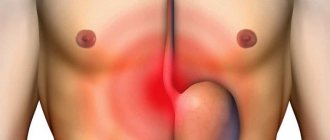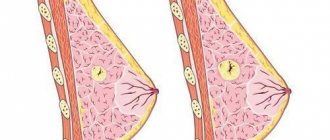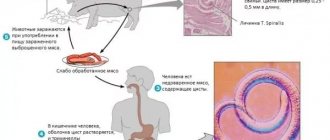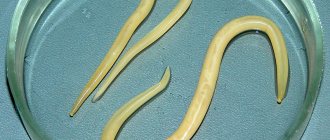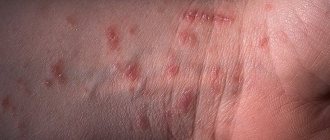Worms in the human intestine can parasitize for years, and some species for decades. It is often possible to suspect their existence based on characteristic symptoms and signs. In children, the clinical picture is more vivid than in adults. This is due to a low pain threshold and rapid toxic damage to the child’s body from helminth waste products.
What do worm larvae look like: round and tapeworms, flukes
The human body is an ideal environment for the life of various microorganisms and parasites.
No one is immune from worm infestation. Even if you follow the rules of hygiene, the risk of infection still exists. Helminths provoke the development of various diseases, so it is important to know what not only adult individuals look like, but also what worm larvae look like.
What to do in such a situation? To get started, we recommend reading this article. This article describes in detail methods of controlling parasites. We also recommend that you consult a specialist. Read the article >>>
Treatment
The body should be cleansed of worms competently and only under the supervision of a specialist. To combat invasion, doctors prescribe drugs from the group of antiparasitic drugs. The dosage is selected individually.
Deworming tablets
Among the effective tablets:
- Vermox;
- Wormil;
- Fenasal;
- Pyrantel;
- Dekaris;
- Niclosamide;
- Albendazole;
- McMiror;
- Piperazine;
- Praziquantel;
- Nemozol;
- Sanoxal.
Children often have stomach pain from antihelminthic tablets. On the first day this is normal and does not require intervention. It is more dangerous when signs of intoxication appear, which indicates mass death of worms. Therefore, before clearing the intestines of worms, preparatory therapy is prescribed. Patients are infused with detoxification solutions, given enzymes and given a course of antiallergic treatment.
After taking specific medications, repeated detoxification therapy is recommended. In the future, you can use folk recipes for worms as auxiliary methods. The most commonly used infusions are tansy infusions, decoctions of pumpkin seeds, horseradish, garlic and mustard. When localized in the stomach, lavage with potassium permanganate is practiced. If worms are found in the intestines, do enemas with baking soda or garlic juice. To strengthen the immune system, they drink teas with rose hips and do hardening.
Important!
Treatment of helminthic infestations requires the mandatory use of specific medications. It is impossible to expel helminths using folk recipes alone.
What do roundworm larvae look like?
Roundworms are considered the most common parasites that most often infect the human body. Usually infection occurs with roundworms and pinworms. The most dangerous representatives of this group are considered to be whipworm and trichinella - they can cause death.
Pinworms settle in the intestines, causing enterobiasis. Their life span is 5-6 weeks. Larvae can be found after defecation. In the stool you can see single worms or large clusters (at advanced stages). The larvae are white in color and up to 1 cm in size.
Roundworms (nematodes)
The activity of the worm begins at night - the female crawls out of the intestines and begins to lay eggs around the anus. This process is accompanied by itching.
Involuntarily, everyone begins to scratch the itchy area, thereby contributing to the spread of the parasite. Eggs cannot be seen without a microscope.
Whipworms, after entering the body, settle in the upper intestines. Their eggs are also released in the feces. The worms' appearance is distinguished by their thin, hair-like body shape.
Roundworms are distinguished by their red-yellow color and spindle-shaped shape. The danger of the parasite lies in the ability of the larvae to migrate throughout the body, causing serious complications.
In just one day, a female roundworm lays approximately 200,000 eggs.
What parasites live in the intestines
The human digestive system is capable of inhabiting such types of helminths as nematodes, cestodes and trematodes. The first are roundworms of relatively small size. Well-known representatives of the group are roundworms and pinworms.
Cestodes
Flat tapeworms, in the intestines reaching a length of 10–12 meters. They consist of segments and a head and are hermaphrodites. The main route of infection is nutritional (food). Known types of cestodes:
- Bovine and pork tapeworm.
- Echinococcus.
- Wide tape.
- Sheep brain.
Therapy of helminthic infestations caused by cestodes requires the use of toxic drugs. Sometimes surgical removal of the worm is necessary.
Trematodes
Flukes are small, 1–3 cm in length, parasitic worms that infect the intestines, liver or lungs of humans. A prominent representative - the Siberian fluke - lives in the ducts of the hepatobiliary system, provokes the development of pancreatitis, cholecystitis, and hepatitis. The helminth can be destroyed only with the help of specific anthelmintic drugs.
What do tapeworm larvae look like?
Pork and bovine tapeworms are the most common representatives of tapeworms. The name worms comes from their permanent hosts. Worms are distinguished by their flat, segmented shape. The tapeworm larva continuously grows, the number of segments (segments) increases to 2000. This species can reach 5 m.
Tapeworms (cestodes)
The eggs of the parasite are laid in their own segments, which subsequently break off and are able to move independently. They move through the intestines and are eliminated from the body during bowel movements.
Infestation by tapeworms is the most dangerous. They not only provoke a deterioration in health, disrupting the functions of internal organs, but also cause the death of their carrier.
Tapeworm larva in the intestines
All people living and working with livestock are susceptible to infection with this type of parasite.
Dream Interpretation – Blue bugs, worms in toes, squeeze the worm out
Insects in a dream usually symbolize minor problems and troubles. If there are too many insects, then such a dream may mean that either too many unresolved problems have accumulated in your life, or you often get irritated over trifles, which only adds to the troubles in your life, and sometimes irritation can poison the dreamer’s life. And I... After talking specifically with you... Now I understand why a person, that is, you, has nightmares in the form of insects, and so they are nothing more than your internal irritation with others... Because, as the situation highlighted... When communicating with others, you do not know how to speak with arguments to the point, but go to the personality of the interlocutor... It is precisely such things that often subsequently become the cause of any troubles, including problems with your own health, and the situation in your dream - unhealthy. Which exactly coincides with the interpretations of absolutely all dream books about insects. So, madam... Learn to control yourself. And then no one and nothing can harm you. Interpretation of dreams from the Dream Interpretation of the House of the Sun
What do fluke larvae look like?
Helminth infections can lead to numerous health problems, shortening life by 15-25 years. Many parasites are extremely difficult to detect. They can be anywhere - in the blood, intestines, lungs, heart, brain. Symptoms of helminthic infestation can be confused with ARVI, gastrointestinal diseases and others. The main mistake in such cases is delay! If you suspect the presence of parasites, you need to contact a specialist. If we talk about medications and self-treatment, then this antiparasitic complex .
Trematodes can reach a length of 1.5 m. Flukes are considered an advanced type of parasite. They are distinguished by the presence of simple nervous, reproductive, and digestive systems. Invasion by this parasite occurs if a person eats infected, thermally untreated fish.
Fluke larva under a microscope
The parasite larvae are excreted from the body along with feces. They are distinguished by their shape in the form of a capsule with a lid. Typically the larvae are brown or yellowish in color.
After leaving the body, fluke larvae penetrate into the water and infect snails and fish. The worm's oral cavity has two suckers, which allow them to attach to the walls of the internal organs.
Invasion by any type of parasite is accompanied by the development of negative symptoms, which only get worse if ignored.
The appearance of worms and their larvae differs from each other. However, all of them can penetrate the human body, becoming the cause of the development of many diseases, the treatment of which is not an easy process.
It is better to avoid infection than to be treated for it. To do this, it is important to adhere to the rules of personal hygiene and various preventive measures.
Worms in the stomach: types of parasites, consequences of infection and methods of removal
For a long period of time, a person may not even suspect that there are parasites in the body, because the signs of their presence are very similar to other diseases and their course. Worms in the stomach can actively live and reproduce, but not all species are suitable for such a habitat.
Types of worms
In addition to large worms, the following can also live in the stomach:
- wide tapeworm (tapeworm);
- roundworms;
- intestinal hookworm;
- pinworm;
- schistosomes;
- eel;
- trichinella;
- flat whipworm;
- dysenteric amoeba;
- Giardia;
- cestode.
Each helminth is capable of infecting and poisoning the body, reducing it to exhaustion. Therefore, it is important to immediately treat worms and remove them from the stomach.
Consequences of worm infection
If a person has worms in the stomach, then delaying treatment can lead to serious health problems, sometimes even life-threatening. This is due to the fact that during their life, worms secrete poison that damages organs and tissues, sometimes causing severe pain. Even a pet can cause worms. If larvae migrate through the blood, then the natural movement of lymph and blood flow is disrupted. It is also worth noting that obstruction of the bronchi and intestines is not uncommon.
Roundworms lead to severe allergies; this symptom is most often characteristic of this particular parasite. Trichocephalosis can reduce the level of hydrochloric acid in the stomach, causing disruption of the digestive process. The body may lose weight quickly in this case. The consequences of the penetration of worms are difficult to name in general terms; each organism has its own characteristics, and the presence of parasites, their class, length and quantity may vary. Tests are required for an accurate diagnosis and immediate treatment.
Basic methods for removing worms
Any prescriptions that help cure such an ailment as worms in the human stomach should be made by a doctor.
But it is important to note that anthelmintic treatment is based on the use of tablets containing levamisole, mebendazole or albendazole as active substances, or suspensions intended for children. Diethylcarbamazine, for example, is considered a very effective drug. Traditional treatment is also practiced, which can sometimes bring results. Self-medication in this case, like worms in the patient’s stomach, is prohibited, because an untreated illness can provoke a relapse, which is more severe in its symptoms and course of the disease. So any medications must be prescribed by a doctor after a thorough examination and collection of all test results.
Worms can affect various internal human organs. Extraintestinal helminths affect the lungs, heart, brain, and retina of the eyes. But most often, worm eggs enter the gastrointestinal tract along with water and food. Parasites in the human stomach disrupt the functioning of the digestive system and provoke the development of many associated diseases.
It is possible to defeat parasites!
Antiparasitic Complex® – Reliable and safe removal of parasites in 21 days!
- The composition includes only natural ingredients;
- Does not cause side effects;
- Absolutely safe;
- Protects the liver, heart, lungs, stomach, skin from parasites;
- Removes waste products of parasites from the body.
- Effectively destroys most types of helminths in 21 days.
There is now a preferential program for free packaging. Read expert opinion.
Hello, readers of the site about parasites Noparasites.ru. My name is Alexander Lignum. I am the author of this site. I am 23 years old, I am a 5th year student at the Kemerovo State Medical Institute. Specialization "Parasitologist". More about the author>>
The best stories from our readers
Topic: Parasites are to blame for all troubles!
From: Lyudmila S. ( [email protected] )
To: Administration Noparasites.ru
Not long ago my health condition worsened. I began to feel constant fatigue, headaches, laziness and some kind of endless apathy appeared. Problems also appeared with the gastrointestinal tract: bloating, diarrhea, pain and bad breath.
I thought it was because of the hard work and hoped that it would go away on its own. But every day I felt worse. The doctors couldn’t really say anything either. Everything seems to be normal, but I feel like my body is not healthy.
I decided to go to a private clinic. Here I was advised, in addition to general tests, to get tested for parasites. So in one of the tests they found parasites in me. According to doctors, these were worms, which 90% of people have and almost everyone is infected, to a greater or lesser extent.
What do worms and their larvae look like in feces?
Helminthiasis is the most common disease recorded in humans, because only in rare cases does it cause pronounced symptoms. Based on this, many people find themselves infected with helminthiasis, but few resort to its treatment, because they think that such a disease is not typical for them. As a result, some patients are subject to exacerbation of old chronic diseases and the emergence of new ones, ending in death. To prevent this type of complication, you should know how to recognize worms in the stool of an adult or child.
Methods of infection with helminthiasis
Worms are flat or round worms, distinguished by body length and body structure. They multiply quickly, laying eggs, and then a person independently transmits them to healthy people who are negligent in hygiene standards and food processing. Most often, people become infected for the following reasons:
The last thing a person thinks about is the possibility of infection with helminthiasis. This is due to the microscopic appearance of helminth larvae, which are practically invisible to the naked eye. That is why a person’s instinct of self-preservation does not work, and he begins to be negligent about hygiene.
Who should be wary of helminthiasis?
Considering that the danger of helminth infection can lurk everywhere, people who do not want to carry out anthelminthic prophylaxis and monitor hygiene may have several varieties of helminths living at once, which do not interfere with each other at all.
Children are most often exposed to helminthiasis. They spend a lot of time playing outside, touching things that are likely to be contaminated with their hands, and then putting their hands in their mouths or eating fruit straight from tree branches. As a result, helminthic larvae penetrate the body, become active, grow and look for a new victim, which becomes the parents of the infected child.
The most common helminth infections among children are caused by pinworms or roundworms. Having reached sexual maturity, they lay eggs directly on the anus. This causes severe itching, the child scratches the irritated area and spreads the larvae throughout the house. This leads to inevitable infection of the parents. Therefore, every parent should know how to recognize worms in their child’s stool and take action while helminthiasis does not pose a serious danger.
Causes
Worms can live and reproduce in the human body for many years. These are parasites that live at the expense of another organism. The worst thing is that a person may not even realize that he is a carrier of these parasitic organisms.
The main factor that influences the prevalence is the lack of a concept of personal hygiene. It is not common for many people to wash their hands when they come from the store or come home from work. And if you remember how many times a day he grabbed door handles or handrails on public transport, it will immediately become clear where the worms come from.
Infection with parasites occurs in three ways:
- through the soil (geohelminthiasis);
- through animals (biohelminthiasis);
- from an infected person.
The common causes of helminthiases include:
- lack of personal hygiene, the simplest thing - a person does not wash his hands before eating, after coming home from work, after a walk;
- drinking running water (without prior boiling);
- contact with pets;
- improper processing of meat and fish;
- eating unwashed fruits and vegetables.
If an adult is not able to take care of himself, then what can we say about his child. It is clear that the child will play in the sandbox, which is located in the yard, where several dogs had previously gone to the toilet, and then he will simply put his hands in his mouth, and now he is already a carrier of parasites.
Or the most common thing is to kiss your pet. Have you ever wondered where he was before this moment? Most likely, he “communicated” with his friends, maybe even ate something, for example, a mouse, and washed down his “lunch” with rainwater.
Do not underestimate the importance of worms, as they are capable of many things. Some can live in the body for quite a long period, feed on your energy, and then lead to complete exhaustion. And others can even cause the development of many diseases, for example, myocarditis, meningitis or central nervous system damage.
General helminth characteristics
In the world, there are about 300 varieties of worms that can infect humans and use them as an intermediate or final carrier. The most common are:
Each of them belongs to an obligate or facultative life cycle:
Moreover, many of them have a common ability - the ability to migrate throughout the body, especially if the larva entered the body through the skin and entered the circulatory system. Then it, along with the blood, is transported throughout the body until it settles in the bile ducts, lungs or other vital organs.
What do worms and their larvae look like in feces?
There are 2 life cycles of helminths:
The first ones are practically invisible, so when a person discovers them, they may not immediately assume that they are infected. However, adults instill horror in humans. They can have different sizes from 0.5 cm - 40 cm or more. Having discovered such a monster in the feces, a person will not put off going to a specialist and treatment.
Despite the fact that they can settle in any organ or system of the human body, the intestines are their most favorite place. In severe stages of helminthiasis, the number of worms and their larvae can reach hundreds or even thousands (depending on the species). It is then that worms in stool (feces) become visible, even to the naked eye (due to their large number).
Worms living in the stomach
We have established that the gastric region is an abnormal habitat for parasites that infect the human body. Can there be worms in the stomach? They can only get there by accident - the helminths are still looking for a comfortable place to live for themselves.
Small parasites (such as pinworms, roundworms, etc.) die even in a slightly acidic environment, so being here is deadly for them. Only large worms remain in the stomach. They are able to survive in its environment for a relatively long time. In particular, these are the following helminths:
- Pork tapeworm. Refers to tapeworms. The final host of the parasite is humans. The length of an adult (mature) individual can reach 3 meters. The main habitat of the worm is the intestinal tract.
- Bull tapeworm. Like the previous one, it refers to tapeworms. The final host of the parasite will also be humans. The helminth is widespread in Eastern Europe, the Philippines, Africa and Latin America. Its adult representatives choose the human small intestine as their place of residence. The size of a mature individual is amazing - from 4 to 10 meters!
- Human roundworm. This is already a round worm. Its length does not exceed 40 cm. It enters the stomach, just like tapeworms, by accident - when a patient coughs up sputum from the lungs and swallows this mass back (through the esophagus into the stomach).
- Toxocara feline or canine. Helminth, as the name suggests, is completely untypical for humans. It can get into the stomach accidentally after contact with a sick animal - if you kissed or stroked a cat or dog. The length of its body usually cannot be more than 12 cm.
- Whipworm. The parasite belongs to roundworms. Its usual habitat is the human large intestine. The main nutrition is tissue fluid and blood. Dimensions – 3-5 cm.
It should be noted that only small (children’s) tapeworm specimens (pork and bovine) can exist in the stomach. Sexually mature representatives simply will not fit in it. The remaining worms in the stomach can be of completely different ages. If the patient’s gastric juice contains even a small amount of hydrochloric acid, this is already an unfavorable condition for the helminth. At any opportunity, he will try to change his place of residence.
Clinical picture of helminthiasis
The migratory stage of helminthiasis is no less dangerous than the adult worms themselves. Moving through the human body, parasites cause complications and pathological diseases, including:
Also, living in the host’s body, parasites can extract various nutrients from it. The whipworm feeds exclusively on red blood cells, as a result of which a person develops anemia; sometimes, the lack of hemoglobin in the blood can reach a critical level. The tapeworm (wide) feeds exclusively on useful substances that enter the intestines, causing vitamin deficiency.
When these enzymes reach critical levels, a person develops related problems. Lack of energy resources, together with intoxication, leads to disruption of the functionality of the central and peripheral nervous system. Then nightmares and irritability appear, and the child begins to lag behind in mental and physical development. This is the second reason why it is necessary to know what helminths look like in bowel movements (stool) and destroy them in time.
Tapeworm in the human body
Tapeworms, like pinworms, live in the human intestines. These are long flatworms that look like a white ribbon. There are many types of tapeworms.
In the intestines of people, two types of tapeworms are most often found: pork, which a person becomes infected with by eating poorly cooked or fried pork meat, and bovine, the source of infection is the meat of cattle. In Ukraine, pork tapeworm is more common.
The bull tapeworm is more common in Siberia and Central Asia. Once settled in the intestines, the tapeworm in a person can live there for years if it is not expelled from the intestines with medications, for example, fern extract.
The structure of the tapeworm, in contrast to the structure of the earthworm, is associated with the conditions of its habitat in the human intestine. Its body is flat. Therefore, tapeworms, like other worms with a similar body shape, are called flatworms. The long, ribbon-shaped body of an adult pork tapeworm reaches a length of 1.5–2 m, and sometimes more.
Helminth worms. Tapeworms cause great harm to both humans and animals. They cause excessive appetite, indigestion, abdominal pain, anemia, sometimes insomnia and nervous diseases in humans.
Like other animals that live in the dark, these parasites have a colorless, white or yellowish-white body. It consists of a tiny, pinhead-sized, round head, thin neck and a large number of segments. The number of segments can reach 1000.
The further from the head, the larger and wider the segments become, as reproductive organs with a huge number of eggs develop in them. New segments form in the back of the neck. There are four suction cups arranged crosswise on the sides of the head. In front of the tubercle, the head has a double corolla, consisting of 22 - 32 hooks.
With these hooks, the tapeworm penetrates the intestinal wall and then attaches itself with its suckers. The tapeworm attaches to the intestinal walls not only with its head, but also with the entire surface of its body, with the irregularities of which it replaces the walls of the human intestine.
The entire surface of the tapeworm's body is covered with dense skin, which protects it from the action of human digestive juices. The tapeworm does not have a mouth opening or digestive organs. Yes, he doesn’t need them, since he eats already digested human food. The tapeworm absorbs it in liquid form over the entire surface of the body.
Helminth worms. In addition to the pork tapeworm, the bovine tapeworm can also live in the human body. The bovine tapeworm is longer than the pork tapeworm. The length of its body reaches 4 – 10 or more meters, and in some cases – 25 – 30 meters.
Under such conditions, a huge number of generations of tapeworm existed. As a result, this animal's digestive organs completely disappeared. Due to its parasitic lifestyle, the tapeworm's nervous system has a very simple structure, and it has no sense organs at all.
What do worm larvae in humans look like in the photo?
Parasites that infect humans go through 3 stages of development. The most dangerous and accompanied by vivid symptoms can be called the second, in which the worm larvae hatched from the eggs begin to migrate throughout the body in search of a place for their further residence. They can be found in any internal organ, under the skin and even in the eyes. The symptoms in this case do not at all resemble helminth infestation, which is why it can be quite difficult to find out the obvious cause of the appearance of negative signs. Only a small part of the parasites remain living in the intestines.
What do worm larvae look like in the photo? This question interests many. But it is not possible to see parasites with the naked eye, they are so microscopic. They can only be seen in photographs taken using a microscope. They do not look as terrifying as adult helminths, but they often cause much more harm. The larval stages of the well-known and most widespread worm from the class of nematodes - roundworms, localized in the body, affect the tissues of the lungs and liver, causing extensive allergic reactions. Numerous foci of hemorrhages in the internal organs that arise due to their implementation provoke the development of serious diseases such as pneumonia and cirrhosis of the liver. Worm larvae in humans not only cause poisoning of the body through their toxic effects, but also cause such serious disorders as:
- Mechanical pressure on internal organs and their rupture;
- Destruction of cells in host tissues due to active movement (migration);
- Anemia, internal bleeding, metabolic disorders.
At the initial stage of colonization of worm larvae into the body, the infested patient may experience the appearance of symptoms of diseases such as myocarditis, pneumonia, conjunctivitis, and hepatitis. It is very difficult to compare it with helminthiasis, and therefore the patient is often unsuccessfully treated for uncharacteristic manifestations caused by the fact that the cells of the human body are dividing intensively, trying to restore tissues damaged by parasites. In order to identify the true cause of the disease, it is necessary to conduct a blood test for antigens to helminths, since a conventional stool test in this case is not informative.
Nematodes are human roundworms: routes of infection, diagnosis and treatment
Up to several hundred nematodes can parasitize the human body. By multiplying and living in it, they harm human health.
Untimely treatment very often leads to serious illnesses and, sometimes, irreparable changes in the body.
General characteristics of roundworms
What are nematodes? In medicine, the characteristics of nematodes are as follows: roundworms that live freely in nature and parasitize the body of humans and animals.
To date, more than twenty-five thousand nematode roundworms are known. The most common parasites in the human body are roundworms, pinworms, hookworms or whipworms.
All types of nematodes, which number in large numbers, can be combined according to the following characteristics:
- All parasites have a round body, inside which the respiratory, nervous, digestive and reproductive systems can be found;
- Males and females differ in size and shape. The female nematode is slightly larger;
- Absolutely all types of roundworms go through all stages of development from larvae to adults;
- Nematodes reproduce by laying eggs.
The entire life cycle of nematodes occurs in several stages: the eggs or larvae of the parasite enter the body and begin to rapidly grow into an adult. After which, in a short time they are able to multiply to large numbers.
After fusion, the male dies and leaves the body with feces, and the female lays larvae.
Routes of infection
Most often, parasites enter the human body through the digestive tract. This may be caused by dirty dishes, hands, water or food. You can become infected with roundworms after being bitten by insect carriers: at this moment, worm larvae enter the human body and begin to reproduce.
Small wounds and cracks on the body when working with contaminated soil can become an open channel for infection.
Children of preschool and school age are most often at risk. Families with pets can become infected with worms through the fur of cats and dogs; people who have daily contact with cows, sheep or the earth.
Infection with parasitic roundworms in humans occurs through contact with an infected patient, cats, dogs or cows. An adult hookworm lives in the human small intestine, attaching itself to its walls using an oral sucker. An adult female can lay up to thirty thousand eggs per day. Female parasites live longer than males, and their age can reach eight years.
Parasite eggs enter the environment through the feces of an infected person: at this point they do not pose a danger; invasiveness begins approximately on the seventh day. On the second day, larvae emerge from the eggs and, for best development, choose moist soil for themselves.
The larvae enter the human body again through contact with animals or an infected patient and quickly begin to mature in it. This takes about five weeks, after which they are able to reproduce.
Nematodosis can appear in absolutely any human organ, so tissue damage very often occurs, inflammatory processes, organ dysfunction, and severe allergic reactions begin.
Nematodes in humans absorb nutrients and vitamins, poisoning the body with waste products and decomposing remains of dead individuals.
Therefore, parasites very often become the causes of blood anemia, reducing the immune system, causing apathy, weakness, and slow development.
Symptoms and types of disease
Roundworms are human parasites that enter the body and most often parasitize the digestive tract. Therefore, the infected person may experience unpleasant painful sensations in the abdominal area, vomiting and loose stools. Some types of helminths can cause severe itching in the anal area.
Nematodes can migrate throughout the human body, affecting neighboring organs.
| Worms in human eyes: infection, symptoms and treatment |
Larval helminthiases
This medical term means that the patient has been infected with tapeworm larvae that have affected one of the internal organs. In this case, people are only intermediate hosts; the parasite cannot develop until the sexually mature stage. Despite the fact that infestation by worm larvae lasts a short time, it is very dangerous and, if not detected, causes irreversible damage to vital organs. You can see what the liver, heart or lungs in which the parasites have settled look like in photos located on specialized websites or in medical reference books. The following larval helminthiases are considered the most common in our country:
- Cysticercosis. Caused by the tapeworm, pork tapeworm. This disease can affect the skin, eyes, lungs, heart, brain or spinal cord. Irreversible changes occur in any of the organs where the helminth larvae are localized. Only correct diagnosis and timely adequate treatment will help the patient avoid serious health problems, and sometimes even death. You can see what the infection cycle of this parasite looks like in the attached image;
- Echinococcosis is caused by Echinococcus larvae. Worm eggs enter the body if personal hygiene rules are not followed, or from the fur of domestic and wild animals. The lungs and liver are most often affected, where cysts form.
Since infection with extraintestinal helminthiases most often occurs when eating meat or fish that have undergone insufficient heat treatment, many are interested in the question of at what temperature the larvae of worms die. The answers to this question can be found completely different, so in order to completely protect yourself from possible infection, you should consult the opinion of experts:
- When frozen at -40°C, worm larvae in meat or fish die within 3 hours. But not a single modern freezer supports it, so we should focus on the optimal temperature for our freezers -18°C. With it, helminths can be destroyed within a week;
- Long-term boiling and frying of the product will ensure safety. In order to eliminate worm larvae in meat, at least 1.5 hours of heat treatment is required. For fish, this time is reduced to 20-30 minutes. Also, for lovers of delicacies, you should keep in mind that the larvae of worms can only be destroyed using the hot smoking method.
How to take a stool test for helminth eggs
DOCTORS RECOMMEND!
Pinworms, Giardia, tapeworm, helminths, tapeworm... The list goes on for a long time, but how long are you going to tolerate parasites in your body? But parasites are the main cause of most diseases, from skin problems to cancer. But the chief television doctor of Russia, Sergei Agapkin, assures that it is easy to cleanse your body even at home, you just need to drink... Read more »
First of all, the feces are determined and examined for protozoan helminth eggs. According to the latest statistics, the number of infected people is approximately 90%. The parasitic disease affects both children and adults, regardless of the conditions. To detect parasites in the body and make an accurate diagnosis, you need to contact a professional specialist.
During the examination of the patient, the doctor prescribes a procedure for taking a stool test for parasite eggs. After identifying an accurate diagnosis, the specialist selects the most suitable drug. In modern medicine, several procedures are performed to determine the diagnosis. The doctor requires at least 2 or 4 tests with and without a microscope. The first important test is a scraping for enterobiasis. Using this analysis, the form and extent of the disease is determined. This procedure is carried out throughout the year.
In order to carry out the analysis, you do not need any specific preparation. The only recommendation from doctors is not to go to the toilet beforehand, so as not to touch the anal area. It is not advisable to go to the toilet before going to see a doctor. This way, the doctor can get a more reliable result.
Taking feces for helminth eggs occurs as follows. The algorithm for collecting feces for helminth eggs is extremely simple.
In the morning, between 6-7 o'clock, the patient empties into a potty. After that, a small amount of feces is taken with a stick and placed in a container for analysis. The feces are sent to the laboratory immediately after collection.
Below is a photo of helminth eggs in feces.
Photos by type
Any worms that settle in the internal organs of a person and feed on trace elements, minerals and human resources are called helminths. Statistics show that about 30% of the population are susceptible to helminth parasitism, and worms can colonize any system and organ, migrate and reproduce en masse. Increased infestation and refusal of treatment can lead to death.
Worms in human feces photo:
How to determine the presence of parasites?
Given the prevalence of parasites, there is a large list of diagnostic measures to check whether a patient has worms in the body.
In some situations, stool analysis is ineffective and may not show the presence of parasites. And not all types of helminths can leave the body, so sometimes they go completely unnoticed.
When a doctor suspects helminthiasis in a patient, he may recommend a stool test, but in addition, he will also prescribe other tests.
The fact is that fecal analysis may show a negative result, since parasites reproduce with a certain frequency, which is not possible to guess.
You can check for the presence of worms in the patient’s body through the following diagnostic measures:
- Enzyme immunoassay of biological fluid (blood). When there are parasites in the patient’s body, the human immune system synthesizes specific antibodies, and their presence indicates that the patient has a helminthic infestation.
- Bioresonance method. This method of diagnosis is based on the fact that every living creature has a certain frequency of radiation, and worms are no exception to the rule. There is a special device that makes it possible to check in which internal organs helminths have settled.
- PCR diagnostics is carried out on the basis of DNA analysis, as a result of which helminthiasis can be diagnosed.
Thanks to modern diagnostic measures, it is possible to detect foci of parasite infection, but this is not always possible to do on time.
Many patients do not pay attention to the symptoms for a long time, so some helminthic infestations remain undiagnosed.
Signs of infestations
In order to detect in time the “neighborhood” with one or another type of parasite, you need to be able to distinguish the characteristic symptoms of infestations. Doctors identify the following signs:
- itching in the anus;
- nausea and vomiting;
- dizziness and regular headaches;
- stool disorders;
- allergic skin rashes;
- dysbacteriosis;
- weight loss or gain;
- lack of appetite, followed by insatiable hunger;
- weakness and fatigue;
- pain in muscles and joints;
- yellowness of the mucous membranes and skin.
If a person exhibits at least several signs from the above list, it is worth seeking advice from a specialist and also getting tested. Any helminthic disease can be asymptomatic for a long time, while the intensity of the invasion will increase.
Diagnostic methods
Whether there are worms with stomach pain can only be determined by a comprehensive diagnosis. Its methods in this case include the following:
- Biochemical and general analysis of patient blood samples.
- Tests for the antigen-antibody complex.
- Endoscopic examination.
I would like to dwell on the last diagnostic method. Endoscopy is the insertion of a special thin probe into the patient’s stomach through the esophagus, at the end of which there is a video camera. This research method helps determine many things:
- Visual detection of large helminths by a specialist.
- Detection of traces of waste products that have settled in the stomach, parasites.
- Assessment of the general condition of the stomach.
- The basis for determining a particular treatment is from stopping bleeding to removing the established parasite.


